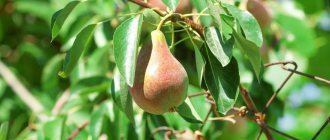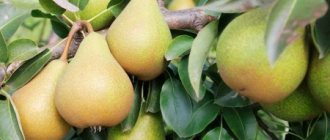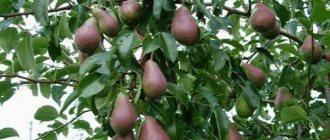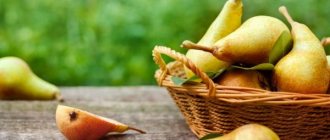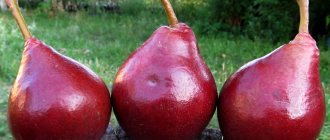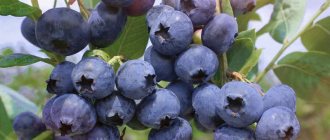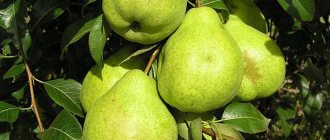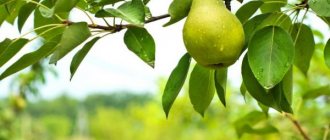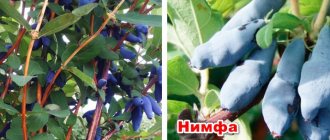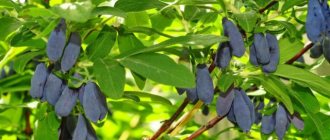Gardening » Pear
0
867
Article rating
Kira Stoletova
The Otradnenskaya pear was obtained from two species - Forest Beauty and Tyoma; it was entered into the state register in 2000. Gained popularity in the Moscow region.
Pear variety Otradnenskaya
What type of pear is it?
Otradnenskaya pears ripen in September ; they are an autumn pear with a shelf life of up to 4 months . During storage, the fruits acquire colors and sweetness, greenish-yellow at the time of picking, they gradually turn yellow, and the washed-out red blush becomes much brighter.
The disadvantage of this variety is
the lack of a characteristic pear aroma and juiciness , but who said that everyone likes the smell of pear?
And the dense sweet pulp has no less lovers than the loose juiciness.
Everything is decided by the individual taste of the gardener, and you shouldn’t draw the line with the words “technical variety”; the Otradnenskaya pear is a variety of wide possibilities, but you can find out which ones further in the description and see in the photo what the fruits look like.
Autumn varieties also include pears: Svetlyanka, Bere Bosk, Tatyana, Uralochka and Larinskaya.
Advantages and disadvantages
This hybrid is characterized by numerous advantages:
- early fruiting periods;
- high immunity to diseases and pests;
- good presentation;
- resistance to all weather disasters;
- excellent frost resistance;
- long shelf life and the ability to transport over long distances;
- ease of cultivation and care;
- resistance to shedding.
Among the shortcomings, insufficient juiciness of the fruits is noted.
Photo
Pear
Pear is our favorite fruit, which we are always happy to eat. Previously, the pear fruit tree was grown only in the southern regions. Now the culture has firmly established itself in more temperate latitudes and even in Siberia and the Urals, thanks to new winter-hardy hybrids, of which there are currently many. But how to choose the right variety for our plots?
This article will help us with this, which will describe the Otradnenskaya pear, its characteristics, as well as its pros and cons. Despite the fact that the variety is relatively new, it has already managed to win the hearts of summer residents and gardeners, especially those living in regions with a cool climate.
Photo of Otradnenskaya pear.
Description of the variety and its characteristics
The Otradnenskaya pear was created at the end of the last century by plant breeders S. Chizhov and S. Potapov at the Moscow Agrarian University. Timiryazev. The mother varieties of the hybrid are Lesnaya Krasavitsa and Tyoma.
When creating a new type of crop, scientists tried to achieve high winter hardiness with the same high yield. And they succeeded.
Otradnenskaya instantly fell in love with gardeners and quickly spread across the vast territory of our country.
Ripening and harvesting dates
Otradnenskaya is a late-ripening hybrid. The first fruits begin to ripen in early September. Mass ripening occurs in the middle of the month. Then they begin to harvest. If pears are not picked on time, they will not fall off and will not lose their presentation and taste.
Productivity
The productivity of the hybrid is at its best. Fruiting of trees occurs already 3-4 years after planting the seedlings. Up to 40 kg of fruits are collected from one tree aged 7 years and older. It is characteristic that this type of pear can produce harvests even under unfavorable weather conditions.
Shelf life and transportability
Otradnenskaya pears have a fairly long shelf life. Under special conditions they can be stored for about 4 months. The fruits of this species are perfectly transported over long distances without losing their presentation and taste, for which the variety is valued by farmers who grow it for commercial purposes.
Climate and growing regions
The hybrid is characterized by high winter hardiness (up to -35 degrees) and excellent drought resistance. It is unpretentious and withstands all natural disasters well. It is grown in the Middle Zone, in the Volga-Vyatka region, in the Middle Volga, in the Central regions, in the North-West and even in Siberia and the Urals.
Diseases and pests
This type of crop has a high immunity to diseases and pests, but a minimal risk of disease still exists. In rare cases, in humid and cloudy weather, trees and fruits may be affected by:
- scab, which is manifested by the appearance of olive spots with a velvety coating on the lower part of the leaves. Then the disease spreads to the fruits, which become covered with ugly dark putrefactive spots and subsequently crack. Prevention from the disease is to treat trees three times with 1% Bordeaux mixture (for 10 liters of water - 100 g of copper sulfate and 150 g of lime). The first treatment is carried out before the leaves bloom, the second - before the buds open, and the third - after flowering;
- fruit rot or moniliosis. A sign of the disease is brown spots on the fruit that grow over time. The fruits begin to rot, causing them to dry out or fall off. As a preventive measure, trees are sprayed in spring and autumn with a 1% solution of Bordeaux mixture, as well as with milk of lime (1 kg of the drug per 10 liters of water);
- powdery mildew, characterized by the formation of a white powdery coating on the leaves, as a result of which the latter curl into a tube and dry out. Shoots and inflorescences are also affected. If the disease has made itself felt, then it is necessary to remove and burn all the diseased parts of the plant, and treat the tree itself with a solution of Fundazol with laundry soap (for 10 liters of water - 50 g of the drug and 10 g of grated soap). For preventive purposes, pear trees are treated several times a season with a 1% solution of Bordeaux mixture).
Scab on a pear.
Pears can also suffer from attacks by insect pests:
- pear moth;
- pear aphid;
- gall mite;
- pear flower beetle.
Insecticides Karbofos, Actellik, Metafos, Aktara or Iskra-M will help fight this scourge. Treat trees against pests before and after flowering.
Advantages and disadvantages
This hybrid is characterized by numerous advantages:
- early fruiting periods;
- high immunity to diseases and pests;
- good presentation;
- resistance to all weather disasters;
- excellent frost resistance;
- long shelf life and the ability to transport over long distances;
- ease of cultivation and care;
- resistance to shedding.
Among the shortcomings, insufficient juiciness of the fruits is noted.
Landing
The algorithm for planting the Otradnenskaya pear differs little from the rules for planting other pear varieties:
- Pear seedlings are planted both in the spring, after the soil has completely warmed up, and in the fall, before frost sets in;
- Biennial plants with a well-developed root system are best suited for planting;
- pear prefers fertile, well-lit, dry areas with groundwater no closer than 2 meters from the surface of the earth;
- the planting area is dug up ahead of time, roots and weeds are removed, and fertilizer is applied;
- a month before planting, prepare holes measuring 80 x 80;
- then the hole is filled halfway with fertile soil mixed with fertilizers (humus, superphosphate and wood ash);
- A mound is formed on top, a seedling is placed on it, the roots are straightened and covered with earth. Then they are compacted, watered abundantly and mulched with peat, humus or rotted mullein.
Care
Standard care for Otradnenskaya pear:
- Young pears need to be watered at least once a week. Mature trees are watered as the soil dries out;
- fertilizing is carried out at least three times per season. In the spring, organic matter mixed with nitrogen fertilizer is added. In summer, phosphorus and potassium complexes are used, and in autumn - humus, a solution of cow manure or chicken droppings;
- to avoid disease, the soil is cleared of weeds and organic residues that may contain fungal spores and insect larvae;
- through loosening, they provide oxygen access to the root system;
- using pruning, thin out and form the crown;
- do not forget about preventive treatment of trees against diseases and pests;
- Before the onset of cold weather, pear trunks are whitened and wrapped in burlap or agrofibre. Young trees are covered.
Reviews from gardeners about the Otradnaya pear
Although the variety was developed relatively recently, it has become a favorite among gardeners, especially those living in temperate and northern latitudes, for its high winter hardiness and unique ability to survive in extreme weather conditions.
The hybrid has a high yield, a long shelf life of its fruits and excellent transportability.
Gardeners also highly appreciate the excellent immunity to fungal diseases and pests, the early fruiting period and the good presentation of pears, however, not everyone likes their taste - some consider them a bit dry. In general, they respond positively to the variety and do not intend to abandon it.
Characteristics
The plant is self-fertile , but if there is cross-pollination, the yield is much higher.
Moskvichka, Mramornaya, Naryadnaya Efimova are recognized as the best pollinators , but if it is not possible to plant them, the neighbor’s pears or the wild game behind the fence will help out.
The Otradnaya pear variety is unpretentious, tolerates adverse weather conditions well, and is not affected by scab.
Scab-resistant pear varieties: Rossoshanskaya beautiful, Severyanka red-cheeked, Lel, Orlovskaya beauty, Chizhovskaya, Skorospelka from Michurinsk, Severyanka, Feeriya.
Diseases and pests
Otradnenskaya pear is highly resistant to scab and other fungal diseases. It is rarely affected by pests. Prevention is enough to help maintain the healthy state of the variety. Detailed instructions on protection and prevention can be read here.
Dangerous Pear Pests
Pears often suffer from pests, they affect the leaves, bark and fruits.
In this article, we have selected 11 of the most harmful insects that harm pear trees, and also ways to destroy them.
Diseases of pear trees
To get what they cherish, gardeners have to work hard, and the reason for this is pear diseases.
Read about 19 common pear diseases and how to combat them.
History of selection and region of breeding
S.T. Chizhov and S.P. Potapov - breeders of the Moscow Agricultural Academy named after. K.A. Timiryazev, obtained this variety by hybridization from the Tema and Lesnaya Krasavitsa varieties.
The tasting rating of the fruits of this pear is 4.3 points.
The late autumn pear variety Otradnenskaya is included in the State Register and, according to its description, zoned in the Central Black Earth region.
In this region, the following pear varieties grow well: Pamyati Zhegalova, Tonkovetka, Yanvarskaya, Gera and Krasulya.
Reviews from gardeners about the Otradnaya pear
Although the variety was developed relatively recently, it has become a favorite among gardeners, especially those living in temperate and northern latitudes, for its high winter hardiness and unique ability to survive in extreme weather conditions.
The hybrid has a high yield, a long shelf life of its fruits and excellent transportability. Gardeners also highly appreciate the excellent immunity to fungal diseases and pests, the early fruiting period and the good presentation of pears, however, not everyone likes their taste - some consider them a bit dry. In general, they respond positively to the variety and do not intend to abandon it.
Planting and care
- Selecting a location The health of the tree, productivity, quality of fruit and its life expectancy will depend on whether you have chosen the right place for planting.
The Otradnenskaya pear variety has a low growth rate, but despite this, choose a freer place for it, with good lighting and ventilation.Do not plant pears near walls, fences, or between buildings; young plants will stretch out, a full-fledged crown will not be able to form, and you may not dream of a good harvest.
With soil everything is much simpler. Insufficiently fertile soil can be fertilized and improved when planting pears.
- Landing
Pear trees can be planted in both spring and autumn, but autumn planting does not guarantee good rooting and it is better to postpone planting to the spring, and bury the seedlings for the winter, placing their roots in a shallow ditch, placing the trunk and crown above the soil at an angle of 45 degrees.
The roots are dug in and covered with available material, and in the spring, after carefully inspecting them and removing possible damage, the seedlings are transferred to a permanent place.The plant tolerates transplanting to a new place painfully; one- and two-year-old seedlings take root most easily ; the older the plant, the greater the chance of losing it.
Seedlings grown in containers can be planted in a permanent place throughout the growing season. At the location chosen for planting pears, the required number of planting holes are dug, at least a meter deep and 80 by 80 centimeters in diameter, with a distance of at least 3 meters between seedlings. Although the Otradnenskaya variety does not have great growth vigor, any pear does not tolerate thickening.
The top layer of fertile soil is deposited separately from the less fertile lower layer, a bucket of humus, a glass of superphosphate, half a glass of potassium salts, a shovel of wood ash , everything is thoroughly mixed.
A mound is built in the center of the planting hole, the soil is slightly compacted, the roots of the seedling are evenly distributed along the slopes of the mound and gradually, evenly covered with soil with constant compaction.
The formation of air pockets leads to rotting of the root system with further death of the plant.
The root collar should remain five centimeters above the soil surface ; when watering the seedling, the soil settles and the root collar will be in the desired position.
When watering, water will not spread if sides are made from less fertile soil deposited when digging a planting hole. Watering should be plentiful. The planting should be completed by driving a peg not far from the seedling, but so that it does not interfere with the seedling, and tying the pear tree to it with twine so that it does not interfere with the development of the future tree.
- Watering The first year after planting the plant requires constant monitoring, it must be watered as needed, the soil should be loosened, this simple event prevents the evaporation of moisture.
Before fruiting begins, it is better to dig up the trunk circles without damaging the root system; open trunk circles make it possible to weed, loosen and water the soil as needed.Pear trees do not tolerate waterlogging well, and as they grow older, there is no need to water them more than once a month in the absence of rain.
- Pruning and care
When planting an annual seedling, the plant is shortened to a height of no more than a meter; buds located below 50 centimeters must be removed.
A two-year-old seedling, after planting in a permanent place, is cut to one third of the length of the shoots , this allows the root system of the young plant to actively develop.A pear planted as an annual seedling undergoes the same pruning in the second year after planting. The pear is prone to self-formation of the crown and there is no need to interfere with this process unnecessarily.
The Otradnenskaya pear variety is early-fruiting, the first fruits appear 3 or 5 years after planting, and with the beginning of fruiting sanitary pruning is carried out , which will eventually be replaced by sanitary rejuvenating.
Otradnenskaya pear is a frost-resistant variety , but if freezing occurs, keep in mind that replacement shoots must be fixed horizontally with pegs and twine, otherwise they will not bear fruit.
Rogneda, Duchess, Severyanka, Lira and Lel can boast of good frost resistance.
With the beginning of fruiting, digging around the tree trunks should be replaced by tinning and weeding should be replaced by mowing the grass. The trunks and skeletal branches of a young tree do not need to be cleaned, but as it matures, dead bark appears, it must be removed using a scraper, and possible wounds should be treated with iron sulfate 3%.
Debris from cleaning the bark must be burned ; insect pests, fungal spores, lichens and mosses overwinter in the cracks of the dead bark.
For whitewashing you need to take equal parts lime and clay and 100 grams of iron sulfate per bucket of working solution ; after mixing, the whitewash should have the consistency of liquid sour cream.
Cleaning of trunks and whitewashing should be carried out in early spring.
In autumn, it is necessary to remove mummified fruits from trees, collect fallen leaves and burn them; pests and disease spores overwinter in fallen leaves and diseased fruits.
Features of planting pear seedlings of the Otradnenskaya variety
This variety can be planted twice a year. This could be in the autumn or spring months. If the seedling was grown in a container, then it can be planted at any time as long as the weather is warm.
Fruit trees planted in the autumn months grow more slowly. Therefore, experienced gardeners recommend planting pears in the spring, even if the seedling is received in the fall.
Where is the best place to plant
Important conditions for a good growing season are sufficient light and adequate air circulation. The pear tree is not very picky about soil characteristics, but if the soil is poor, then before planting the tree it is enriched with the necessary components.
It should be remembered that the seedling should be planted in an area where there are no large trees or buildings nearby.
Step by step planting process
For planting Otradnenskaya pears, only healthy young seedlings are selected. They must be free of defects. Then the dimple is prepared. Its diameter should be approximately 80 cm and its depth should be at least 1 m.
It is better to choose specimens that are less than two years old. The older the seedling, the less likely it is to be successfully planted.
The top fertile layer of soil must be carefully removed. Then mix it with mineral and organic fertilizers. Add about 10 liters of compost, 0.25 superphosphate, 3-4 “palms” of ash and 0.15 liters of potash fertilizers to the resulting substrate. A cone is formed from this soil mixture at the bottom of the hole, compacting the earth a little. Then the tree is placed so that its rhizome wraps around the cone.
The hole with the seedling is filled with the prepared mixture so that the root collar is several centimeters higher than the soil. This is very important, otherwise after irrigation and subsidence of the soil it will go underground.
Features of cultivation
Although the Otradnenskaya pear can partially self-pollinate, it requires the right proximity for full fruiting. Suitable varietals:
First of all, a place to place the seedling is selected. The space should be open, with good lighting and ventilation. The soil can be absolutely any, the main thing is to fertilize it during planting. The best time to plant a young tree is spring. But this procedure can be performed in the fall.
Humus, ash and complex fertilizers are placed in a planting hole 80 cm deep and 100 by 80 cm in size. The roots of the seedling are carefully straightened and covered with earth.
The final stage of planting is to install a peg or other support next to the pear trunk. They tie the tree with twine very carefully, in several places.
In the first year, it is very important to water the seedling regularly, avoiding drying out and waterlogging of the soil. Also, several times a season the soil around the tree is loosened.
In the spring, the next year after planting, the branches must be pruned. The shoots are shortened by about a third.
The Otradnenskaya pear is distinguished by its stable immunity to common diseases. Preventive treatment is carried out in early spring, before sap flow begins.
Description of fruits
The weight of each pear is 80 - 130 g. The shape is doubly conical. The peel is smooth, without a glossy sheen. The color of the ripe fruit is yellowish-red, with a blurred blush. Inside there are 5-10 medium-sized seeds. When ripe they are dark brown in color.
The pulp is creamy white, fine-grained. The taste is weakly expressed - sweet and sour. The aroma is practically not felt.
Evaluation of the appearance of the fruit - 4 points, taste - 3.7 points.
From each mature pear it is possible to collect 30-40 kg of harvest.
Ripening occurs annually in mid-September. Collected fruits can be stored at zero temperature for 2-4 months without loss of commercial quality. Interesting! During storage, the taste of the fruit slightly improves.
